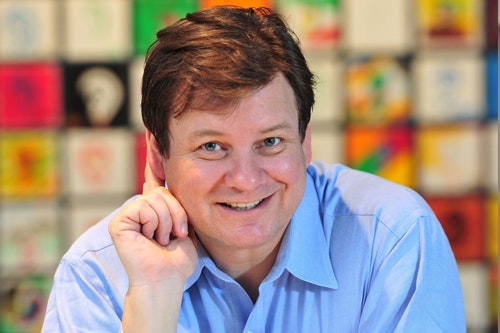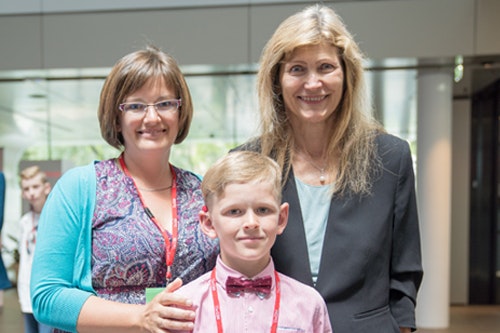Young inventors meet the miracle makers which enable them to hear
June 14, 2019 – (Innsbruck, Austria) – MED-EL Medical Electronics, inventors of world-leading hearing solutions, this week welcomed eight winners of the global children’s contest, ideas4ears, to the company’s headquarters in Innsbruck, Austria.

Ideas4ears, which searches for the next generation of inventors of hearing technology, grand prize included a two-day winners’ trip to Innsbruck (12‑13 June) to provide the children and their families with the unique opportunity to tour the production facility and meet MED-EL’s many inventors.
Over 340 children from 6-12 years of age participated in the contest from 19 different countries. The winners who travel from Australia, Belarus, Chile, Germany, Spain, UK and the USA have the chance to see first-hand where MED-EL’s research and production takes place.
The ideas4ears winners who have benefited from a MED-EL hearing solution will also get to meet the actual team who has produced the cochlear implants that allow them to hear.
“Our unique family of hearing implants can be utilized to treat most types of deafness and hearing loss. How can someone possibly thank an individual enough, who through their daily work has made the device which has given them the gift of hearing."
"Words cannot describe how life changing this is! I can relate as I lost my hearing at an early age and became deaf. However, I did not let my deafness hold me back in life and it only made me more determined to overcome it. Later I went on to invent a middle ear implant solution for my own hearing loss,” commented Geoffrey Ball, Chief Technical Officer at MED-EL and inventor of the VIBRANT SOUNDBRIDGE middle ear implant.

“I invented the Vibrant Soundbridge so that others and especially kids would have the best chance to hear as well as possible and as soon as possible. Without hearing you can’t communicate with others which is really what it is all about…communicating with others,” added Geoffrey Ball.
The winning inventions demonstrated creativity and, through various media and invention prototypes, showcased how they might be able to help improve the lives of people with hearing loss at any age.
“It is really cool that so many children who have a cochlear implant were inspired to enter the ideas4ears contest because of their own life experiences living without sound. Other entries were from children whose loved ones suffer with hearing loss, all with the aim to make the lives of their family members easier,” said Geoffrey Ball.
Impressions from the trip of a lifetime!

Betty, 8 years old from Lymm, United Kingdom wanted to help her father Tom with her invention idea for a customizable helmet for hearing implant wearers. She visited MED-EL with her mother Sadie and older brother Hal.

Fernando, 8 years old from Valladolid, Spain did not want his hearing loss to affect his love of water sports and active adventures, so invented a submersible implant system. He came to MED-EL with his mother Sodi and Father Fernando.

Hleb, 7 years old from Minsk, Belarus wanted to play with other children in the playground without having to worry about losing his cochlear implant, so he invented a Viking Helmet to protect his device. Hleb is also a talented singer and treated us to a performance with his mother Svetlana while in Innsbruck.

Jaylin, 8 years old from Colorado USA loves to dance hip-hop and has not let her vibrant personality be affected by her hearing loss. Jaylin invented an invisible implant solution so that she has the choice to tell people about her deafness when she feels comfortable to do so. Jaylin visited MED-EL with her mother Heather and Grandmother Jody.

Leon, 9 years old from Padbury, Western Australia likes to keep active and enjoys many outdoors activities like fishing, hiking and swimming. His invention included a special ‘wakey wakey’ function on his watch which allows the volume of his cochlear implants to turned up gently in the morning. Leon travelled to MED-EL with his mother Rachel.

Sophie and Eva-Maria, 8 years old from Andechs, Germany (joint entry) created a laser bed which restores the hair cells in the cochlear when you sleep in it. The school friends were very specific in their recommendation that the bed must be slept in twice a week for optimal hair cell restoration. Sophie came to MED-EL with mother Wiebke and Eva-Maria was accompanied by her mother Natalie.

Trinidad, 6 years old from Temuco, Chile has a younger sister Olivia with a cochlear implant and she wanted to make the life of her little sister easier by allowing for solar charging of batteries so that there is no time without hearing. Trinidad came to MED-EL with her mother Claudia, father Patricio and sister Olivia.
Innovation is essential when exploring ways to improve the lives of those with hearing loss and the ideas4ears competition has raised awareness of hearing loss and the benefits of hearing technology. If you are worried about the hearing loss of a family member or for your own hearing loss contact [email protected] to receive a free information package on hearing and the solutions available.
Alternatively, you can contact your local MED-EL clinic to speak with our caring staff who can advise you about the hearing services available in your area.
For more information on the contest, visit: www.ideas4ears.org/meet-the-inventors/ and www.facebook.com/ideas4ears.
About hearing loss
Over 5% of the world’s population – 466 million people – are living with disabling hearing loss (432 million adults and 34 million children).[i] Approximately one-third of people over the age of 65 are affected by disabling hearing loss.1 The World Health Organization recommends a range of interventions to improve communication once hearing loss has occurred, including hearing implants.1
About Geoffrey Ball - ideas4ears Head Judge and Inventor of the VIBRANT SOUNDBRIDGE
Geoffrey Ball's extraordinary adventure in technology began in the legendary Silicon Valley of California and ultimately led him to the mountains of Austria, where he now lives and continues his work. Even as a child, Ball knew that sign language, conventional hearing aids, and lipreading were not for him, so he decided to find a cure for his deafness. Never letting his disability stand in his way, he became a kind of modern Renaissance man with wide-ranging interests and abilities, all coupled with an undeniable talent for entrepreneurship and invention.
About MED-EL
MED-EL Medical Electronics, a leader in implantable hearing solutions, is driven by a mission to overcome hearing loss as a barrier to communication. The Austrian-based, privately owned business was co-founded by industry pioneers Ingeborg and Erwin Hochmair, whose ground-breaking research led to the development of the world’s first micro-electronic multi-channel cochlear implant (CI), which was successfully implanted in 1977 and was the basis for what is known as the modern CI today. This laid the foundation for the successful growth of the company in 1990, when they hired their first employees. To date, MED-EL has grown to more than 2,000 employees and 33 locations worldwide.
The company offers the widest range of implantable and non-implantable solutions to treat all types of hearing loss, enabling people in 123 countries enjoy the gift of hearing with the help of a MED-EL device. MED-EL’s hearing solutions include cochlear and middle ear implant systems, a combined Electric Acoustic Stimulation hearing implant system, auditory brainstem implants as well as surgical and non-surgical bone conduction devices. www.medel.com
CEO
Doz. DI Dr DDr med. h.c. Ingeborg Hochmair
Press contact
Lisa Azwanger-Geser
MED-EL Medical Electronics
Fürstenweg 77a
6020 Innsbruck
Austria
T: +43 5 7788-1029
E: [email protected]
www.medel.com
[i]World Health Organization. Deafness and hearing loss factsheet. Available at http://www.who.int/mediacentre/factsheets/fs300/en/. Last accessed June 2019.
